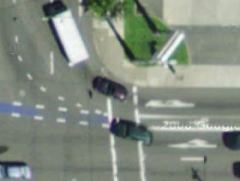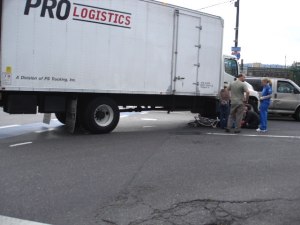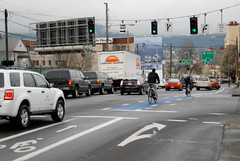
(Photo © J. Maus)
This article was written by Jessica Roberts. Jessica is the former metro area advocate for the Bicycle Transportation Alliance and she is now a planner with Alta Planning and Design, one of the nation’s premier bike and pedestrian planning firms.
Jessica previously wrote about how to get letters published in newspapers.
In the article below, Jessica offers her perspective and gives us a bit of historical context for the infamous Broadway/Williams intersection, which PDOT is currently working to improve.
I used to work as a bicycle advocate at the BTA. One day I got a call from my friend Erik, who described a horrific close call he had just witnessed. A bicyclist was proceeding straight in the westbound bike lane on NE Broadway at Williams and a truck had cut off the bicyclist, causing him to crash and slide across the intersection, narrowly missing being run over by the truck.
I assumed Erik wanted advice from me about legal options, and I launched into my regular spiel. But he interrupted – “no”, he said, the reason he was calling is that the cyclist turned out to be my brother.
“Facilities like the dual right turn lane on NE Broadway are one of the major ways we continue to prioritize cars over people.”
By now, just about every Portland cyclist knows and loathes this intersection. Many cyclists have seen or had close calls like the one Erik witnessed, and when I worked at the BTA I was told that this intersection was the site of a fatal crash. The current facility traps the bike lane between a right-turn lane and a “dual destination” (aka “though-right turn”) vehicle lane. Since drivers have every reason to expect that they can make a right turn from this lane, they regularly conflict with the bicyclist’s straight-through movement.

The current right/right-thru configuration is universally recognized as dangerous and unacceptable. The 1999 Portland Bicycle Master Plan states that this design is to be avoided, the League of American Bicyclists opposes the configuration, former Oregon Bicycle and Pedestrian Coordinator Michael Ronkin states that it is not possible to create a safe bike lane option with this configuration, and the FHWA states that, “this situation is particularly difficult for bicyclists.” (source: FHWA).
The good news is that everyone, including the BAC and PDOT, now agrees that this facility design must go. The bad news is that the true root of the problem, the dual-right turn lane configuration, is not being questioned. This facility, and many others like it in Portland and beyond, continue to tell drivers that the world is their onramp, and continue to provide cyclist safety only secondarily to driver convenience.
Rex Burkholder, current Metro Councilor and former BTA founder, agrees. The Broadway/Williams design, he says, is stuck in a 1960s mentality that has no place in today’s city. “Those lanes exist to speed cars onto the freeway,” he says, “but right now, the onramp has ramp signals anyway, so all we’re doing is help cars speed up so they can stop. Why should we sacrifice bicyclist and pedestrian safety for a gain of two seconds?”
In 1997, the Swedish parliament adopted a policy called “Vision Zero” (PDF). Their goal was to eliminate traffic deaths. The fundamental principle is that “it can never be ethically acceptable that people are killed or seriously injured when moving within the road transport system.”

it forced PDOT to take a closer look at a solution.
(Photo: Carl Larson)
A first step to realizing this vision is to place primary responsibility for road safety on facility designers.
The success of Vision Zero is clear: in 2006, Sweden recorded 440 traffic deaths. Compare that to the US, where 42,000 people are killed every year in traffic deaths. (Even if you normalize for population size, if we had the same fatality rate, we would only see 14,500 deaths per year – in other words, if you know three people who died in traffic crashes, two of them would still be alive.)
Facilities like the dual right turn lane on NE Broadway are one of the major ways we continue to prioritize cars over people, and thus fail to learn from the stellar success of our Swedish colleagues.
PDOT is to be commended for taking on the Broadway/Williams intersection, and the signalized design they are working on may end up working well for cyclists (as long as bikes get a long enough green light). Nevertheless, it’s important to recognize that the reason we’re having to take major steps to fix this situation is that it was rotten to begin with.
Dual right turn lanes are a deliberate trade-off of pedestrian and bicycle safety for increased vehicle capacity. They demonstrate that even in Portland, we still let outdated, auto-centric thinking rule the day far too often. It’s time to do better.



